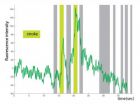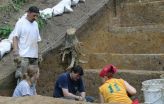(Press-News.org) PASADENA, Calif.—The skin is a human being's largest sensory organ, helping to distinguish between a pleasant contact, like a caress, and a negative sensation, like a pinch or a burn. Previous studies have shown that these sensations are carried to the brain by different types of sensory neurons that have nerve endings in the skin. Only a few of those neuron types have been identified, however, and most of those detect painful stimuli. Now biologists at the California Institute of Technology (Caltech) have identified in mice a specific class of skin sensory neurons that reacts to an apparently pleasurable stimulus.
More specifically, the team, led by David J. Anderson, Seymour Benzer Professor of Biology at Caltech, was able to pinpoint individual neurons that were activated by massage-like stroking of the skin. The team's results are outlined in the January 31 issue of the journal Nature.
"We've known a lot about the neurons that detect things that make us hurt or feel pain, but we've known much less about the identity of the neurons that make us feel good when they are stimulated," says Anderson, who is also an investigator with the Howard Hughes Medical Institute. "Generally it's a lot easier to study things that are painful because animals have evolved to become much more sensitive to things that hurt or are fearful than to things that feel good. Showing a positive influence of something on an animal model is not that easy."
In fact, the researchers had to develop new methods and technologies to get their results. First, Sophia Vrontou, a postdoctoral fellow in Anderson's lab and the lead author of the study, developed a line of genetically modified mice that had tags, or molecular markers, on the neurons that the team wanted to study. Then she placed a molecule in this specific population of neurons that fluoresced, or lit up, when the neurons were activated.
"The next step was to figure out a way of recording those flashes of light in those neurons in an intact mouse while stroking and poking its body," says Anderson. "We took advantage of the fact that these sensory neurons are bipolar in the sense that they send one branch into the skin that detects stimuli, and another branch into the spinal cord to relay the message detected in the skin to the brain."
The team obtained the needed data by placing the mouse under a special microscope with very high magnification and recording the level of fluorescent light in the fibers of neurons in the spinal cord as the animal was stroked, poked, tickled, and pinched. Through a painstaking process of applying stimuli to one tiny area of the animal's body at a time, they were able to confirm that certain neurons lit up only when stroked. A different class of neurons, by contrast, was activated by poking or pinching the skin, but not by stroking.
"Massage-like stroking is a stimulus that, if were we to experience it, would feel good to us, but as scientists we can't just assume that because something feels good to us, it has to also feel good to an animal," says Anderson. "So we then had to design an experiment to show that artificially activating just these neurons—without actually stroking the mouse—felt good to the mouse."
The researchers did this by creating a box that contained left, right, and center rooms connected by little doors. The left and right rooms were different enough that a mouse could distinguish them through smell, sight, and touch. In the left room, the mouse received an injection of a drug that selectively activated the neurons shown to detect massage-like stroking. In the room on the right, the mouse received a control injection of saline. After a few sessions in each outer room, the animal was placed in the center, with the doors open to see which room it preferred. It clearly favored the room where the massage-sensitive neurons were activated. According to Anderson, this was the first time anyone has used this type of conditioned place-preference experiment to show that activating a specific population of neurons in the skin can actually make an animal experience a pleasurable or rewarding state—in effect, to "feel good."
The team's findings are significant for several reasons, he says. First, the methods that they developed give scientists who have discovered a new kind of neuron a way to find out what activates that neuron in the skin.
"Since there are probably dozens of different kinds of neurons that innervate the skin, we hope this will advance the field by making it possible to figure out all of the different kinds of neurons that detect various types of stimuli," explains Anderson. The second reason the results are important, he says, "is that now that we know these neurons detect massage-like stimuli, the results raise new sets of questions about which molecules in those neurons help the animal detect stroking but not poking."
The other benefit of their new methods, Anderson says, is that they will allow researchers to, in principle, trace the circuitry from those neurons up into the brain to ask why and how activating these neurons makes the animal feel good, whereas activating other neurons that are literally right next to them in the skin makes the animal feel bad.
"We are now most interested in how these neurons communicate to the brain through circuits," says Anderson. "In other words, what part of the circuit in the brain is responsible for the good feeling that is apparently produced by activating these neurons? It may seem frivolous to be identifying massage neurons in a mouse, but it could be that some good might come out of this down the road."
INFORMATION:
Allan M. Wong, a senior research fellow in biology at Caltech, and Kristofer K. Rau and Richard Koerber from the University of Pittsburgh were also coauthors on the Nature paper, "Genetic identification of C fibers that detect massage-like stroking of hairy skin in vivo." Funding for this research was provided by the National Institutes of Health, the Human Frontiers Science Program, and the Helen Hay Whitney Foundation.
Written by Katie Neith
Sorting out stroking sensations
Caltech biologists find individual neurons in the skin that react to massage
2013-01-31
ELSE PRESS RELEASES FROM THIS DATE:
Rejuvenation of the Southern Appalachians
2013-01-31
Boulder, Colorado, USA – In the February 2013 issue of GSA Today, Sean Gallen and his colleagues from the Department of Marine, Earth, and Atmospheric Sciences at North Carolina State University take a new look at the origin of the Miocene rejuvenation of topographic relief in the southern Appalachians.
Conventional wisdom holds that the southern Appalachian Mountains have not experienced a significant phase of tectonic forcing for more than 200 million years; yet, they share many characteristics with tectonically active settings, including locally high topographic relief, ...
Empathy and age
2013-01-31
According to a new study of more than 75,000 adults, women in that age group are more empathic than men of the same age and than younger or older people.
"Overall, late middle-aged adults were higher in both of the aspects of empathy that we measured," says Sara Konrath, co-author of an article on age and empathy forthcoming in the Journals of Gerontology: Psychological and Social Sciences.
"They reported that they were more likely to react emotionally to the experiences of others, and they were also more likely to try to understand how things looked from the perspective ...
UNC scientists unveil a superbug's secret to antibiotic resistance
2013-01-31
Worldwide, many strains of the bacterium Staphyloccocus aureus, commonly known as staph infections, are already resistant to all antibiotics except vancomycin. But as bacteria are becoming resistant to this once powerful antidote, S. aureus has moved one step closer to becoming an unstoppable killer. Now, researchers at the University of North Carolina at Chapel Hill have not only identified the mechanism by which vancomycin resistance spreads from one bacterium to the next, but also have suggested ways to potentially stop the transfer.
The work, led by Matthew Redinbo, ...
Binge drinking increases risk of Type 2 diabetes by causing insulin resistance
2013-01-31
Binge drinking causes insulin resistance, which increases the risk of Type 2 diabetes, according to the results of an animal study led by researchers at the Diabetes Obesity and Metabolism Institute at the Icahn School of Medicine at Mount Sinai. The authors further discovered that alcohol disrupts insulin-receptor signaling by causing inflammation in the hypothalamus area of the brain.
The results are published in the January 30 issue of the journal Science Translational Medicine.
"Insulin resistance has emerged as a key metabolic defect leading to Type 2 diabetes ...
Mount Sinai launches clinical trial to treat chronic pulmonary sarcoidosis
2013-01-31
Patients are currently being enrolled in the first clinical trial to investigate the efficacy of immunological therapy for chronic pulmonary sarcoidosis. The trial is being conducted by researchers at the Icahn School of Medicine at Mount Sinai.
Mount Sinai has the largest Sarcoidosis Service in the world and is one of only two institutions in the country participating in the trial; the other is the University of Cincinnati. Mount Sinai is a National Institutes of Health Center of Excellence for research in sarcoidosis.
"The current standard treatment for chronic pulmonary ...
New semiconductor research may extend integrated circuit battery life tenfold
2013-01-31
Researchers at Rochester Institute of Technology, international semiconductor consortium SEMATECH and Texas State University have demonstrated that use of new methods and materials for building integrated circuits can reduce power—extending battery life to 10 times longer for mobile applications compared to conventional transistors.
The key to the breakthrough is a tunneling field effect transistor. Transistors are switches that control the movement of electrons through material to conduct the electrical currents needed to run circuits. Unlike standard transistors, which ...
Satellite image shows eastern US severe weather system
2013-01-31
A powerful cold front moving from the central United States to the East Coast is wiping out spring-like temperatures and replacing them with winter-time temperatures with powerful storms in between. An image released from NASA using data from NOAA's GOES-13 satellite provides a stunning look at the powerful system that brings a return to winter weather in its wake.
On Jan. 30 at 1825 UTC (1:25 p.m. EST), NOAA's GOES-13 satellite captured an image of clouds associated with the strong cold front. The visible GOES-13 image shows a line of clouds that stretch from Canada ...
NASA-NOAA's Suomi NPP satellite sees powerful Cyclone Felleng
2013-01-31
False-colored night-time satellite imagery from NASA-NOAA's Suomi NPP satellite clearly shows bands of thunderstorms wrapping into the eye of Cyclone Felleng as it parallels the coast of eastern Madagascar.
The Visible Infrared Imager Radiometer Suite (VIIRS) aboard NASA-NOAA's Suomi NPP satellite captured a night-time image of Cyclone Felleng when it was located east of Madagascar (4:09 p.m. EST/Jan. 30 at 12:09 a.m. local time, Madagascar). The image was created at the University of Wisconsin-Madison and was false colored to reveal temperatures. The image shows powerful ...
Rutgers physics professors find new order in quantum electronic material
2013-01-31
Two Rutgers physics professors have proposed an explanation for a new type of order, or symmetry, in an exotic material made with uranium – a theory that may one day lead to enhanced computer displays and data storage systems and more powerful superconducting magnets for medical imaging and levitating high-speed trains.
Their discovery, published in this week's issue of the journal Nature, has piqued the interest of scientists worldwide. It is one of the rare theory-only papers that this selective publication accepts. Typically the journal's papers describe results of ...
Archaic Native Americans built massive Louisiana mound in less than 90 days
2013-01-31
Nominated early this year for recognition on the UNESCO World Heritage List, which includes such famous cultural sites as the Taj Mahal, Machu Picchu and Stonehenge, the earthen works at Poverty Point, La., have been described as one of the world's greatest feats of construction by an archaic civilization of hunters and gatherers.
Now, new research in the current issue of the journal Geoarchaeology, offers compelling evidence that one of the massive earthen mounds at Poverty Point was constructed in less than 90 days, and perhaps as quickly as 30 days — an incredible ...
LAST 30 PRESS RELEASES:
Tracing the quick synthesis of an industrially important catalyst
New software sheds light on cancer’s hidden genetic networks
UT Health San Antonio awarded $3 million in CPRIT grants to bolster cancer research and prevention efforts in South Texas
Third symposium spotlights global challenge of new contaminants in China’s fight against pollution
From straw to soil harmony: International team reveals how biochar supercharges carbon-smart farming
Myeloma: How AI is redrawing the map of cancer care
Manhattan E. Charurat, Ph.D., MHS invested as the Homer and Martha Gudelsky Distinguished Professor in Medicine at the University of Maryland School of Medicine
Insilico Medicine’s Pharma.AI Q4 Winter Launch Recap: Revolutionizing drug discovery with cutting-edge AI innovations, accelerating the path to pharmaceutical superintelligence
Nanoplastics have diet-dependent impacts on digestive system health
Brain neuron death occurs throughout life and increases with age, a natural human protein drug may halt neuron death in Alzheimer’s disease
SPIE and CLP announce the recipients of the 2025 Advanced Photonics Young Innovator Award
Lessons from the Caldor Fire’s Christmas Valley ‘Miracle’
Ant societies rose by trading individual protection for collective power
Research reveals how ancient viral DNA shapes early embryonic development
A molecular gatekeeper that controls protein synthesis
New ‘cloaking device’ concept to shield sensitive tech from magnetic fields
Researchers show impact of mountain building and climate change on alpine biodiversity
Study models the transition from Neanderthals to modern humans in Europe
University of Phoenix College of Doctoral Studies releases white paper on AI-driven skilling to reduce burnout and restore worker autonomy
AIs fail at the game of visual “telephone”
The levers for a sustainable food system
Potential changes in US homelessness by ending federal support for housing first programs
Vulnerability of large language models to prompt injection when providing medical advice
Researchers develop new system for high-energy-density, long-life, multi-electron transfer bromine-based flow batteries
Ending federal support for housing first programs could increase U.S. homelessness by 5% in one year, new JAMA study finds
New research uncovers molecular ‘safety switch’ shielding cancers from immune attack
Bacteria resisting viral infection can still sink carbon to ocean floor
Younger biological age may increase depression risk in older women during COVID-19
Bharat Innovates 2026 National Basecamp Showcases India’s Most Promising Deep-Tech Ventures
Here’s what determines whether your income level rises or falls
[Press-News.org] Sorting out stroking sensationsCaltech biologists find individual neurons in the skin that react to massage



